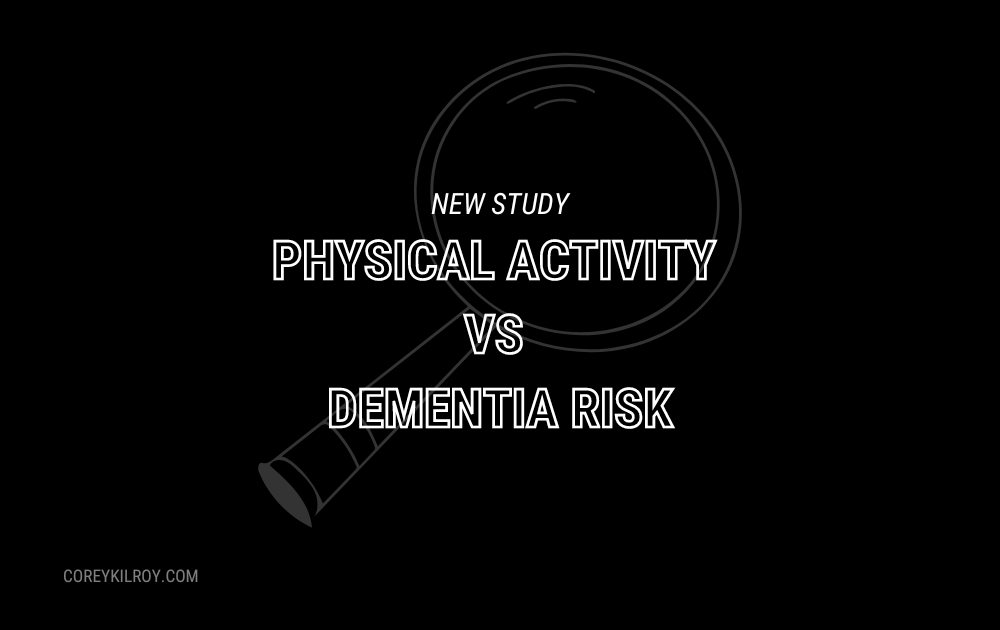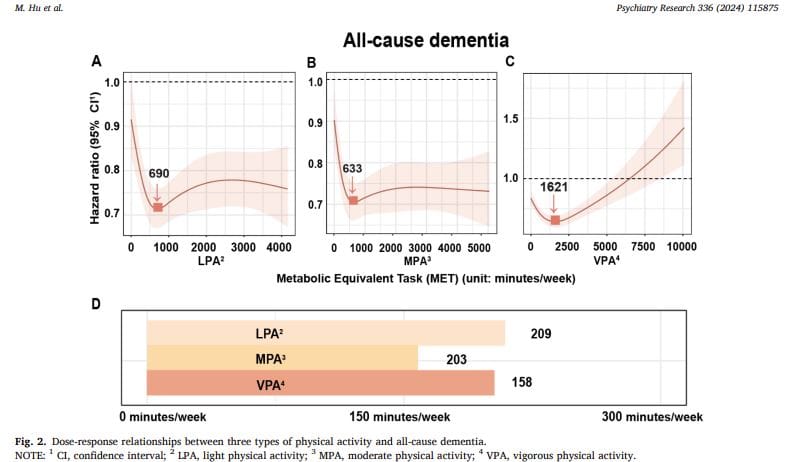Link Between Physical Activity & Dementia Risk

I recently discovered a new piece of literature that I couldn’t wait to share with you.
A recent study came out on the link between physical activity and its relationship with the risk of dementia.
Dementia and Alzheimers are both serious life conditions and almost everyone has a loved one, or knows of someone, with it.
Dementia affects more than 50 million individuals globally, with Alzheimer’s disease being the most prevalent subtype (60-70 %), followed by vascular dementia (25 %) (source)
Here’s a quick summary on the study itself and what it means for you.
How was the study conducted?
Study Design
This study was established by the UK Biobank, where 502,486 individuals participated at baseline.
Participants were excluded if they were
1. less than 45 years old
2. with the self-reported prevalent cognitive impairment or Alzheimer’s disease or
dementia at baseline
3. diagnosed with dementia; and
4. missing data on physical activity and covariates.
At the end of the study, a total of 345,123 participants were included in the final analyses.

Physical Activity Assessment
Physical activity was measured based on several questions that were adapted from the International Physical Activity Questionnaire (IPAQ).
Based on these questions, the frequencies and durations of the three types of physical activity (light physical activity (LPA), moderate physical activity (MPA), and vigorous physical activity (VPA)) were collected and achieved.
Here’s an example of a question in regards to MPA, “In a typical week, on how many days did you do 10 min or more of moderate physical activities like carrying light loads, or cycling at a normal pace?”.
The frequency and duration of walking were also captured.
Additionally, each level of activity was assigned following metabolic equivalent (MET) hour values.
Dementia Assessment
Dementia cases within the UK Biobank were identified through linkage to the hospital in-patient admission records and death registries.
The follow-up on these patients began from the date attending the assessment center to the earliest date of dementia diagnosis, the date of loss to follow-up, the date of death, and/or the censoring (September 2021), whichever occurred first.
Independent variables (Covariates)
Covariates included socioeconomic factors (age, sex, ethnicity, education, Townsend deprivation index), lifestyle factors (smoking status and alcohol status), diseases (stroke, hypertension, diabetes, and depression), and genetic factors (polygenic risk score, PRS).
Additionally, sex was classified as female and male, and ethnicity was categorized as White, Mixed, Asian or Chinese, Black, and others.
Education was classified as higher, upper secondary, lower secondary, vocational, and others. Townsend deprivation index was categorized into three levels (quantiles 1, 2 to 4, and 5), combining information on social class, employment, car availability, and housing).
They also considered phenotype information on dementia, which was assessed using self-reported dementia/Alzheimer/cognitive impairment.
What did the study find? + My analysis

Here’s why you all tuned into this essay—the results.
After following up for a median average of 12.5 years, 5,136 cases of dementia were observed.
However, the mixture effect of light physical activity (LPA), moderate physical activity (MPA), and vigorous physical activity (VPA) on dementia was statistically significant with VPA (weight: 0.7922) contributing most to a lower risk of dementia, followed by MPA coming in a close second (0.1939).
So what does this all mean?
Physical activity played a statistically significant role in reducing the risk of Alzheimer’s disease and vascular dementia.
The scientists of the study also compared physical activity for Alzheimer’s disease versus vascular dementia, which I found interesting.
For Alzheimer’s disease, MPA contributed the most (0.8555) and was identified as the most influential factor for preventing Alzheimer’s disease
And for vascular dementia, VPA contributed the most (0.6271) and stood out as the most impactful for vascular dementia.
This is HUGE news.
Yes, we all know the importance of exercise for all the physical benefits it provides, but many tend to overlook the mental benefits it provides as well.
In the end…
Chalk this up as yet another reason why you should prioritize physical activity in your daily life.
Motion is lotion.
This is an often overused phrase, but it couldn’t be any more true.
Your health span and lifespan significantly increase with the addition of consistent physical activity.
Take that with what you will.
Be well and Keep Pluggin.
-C.



